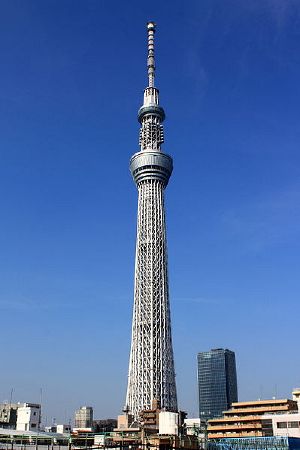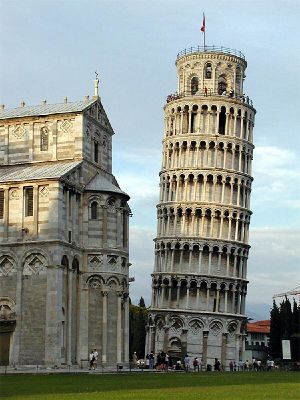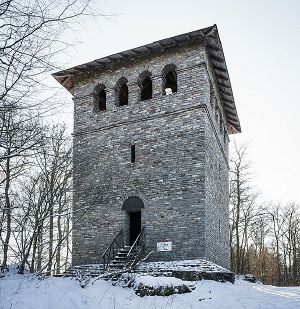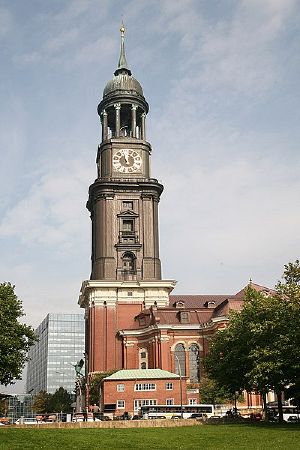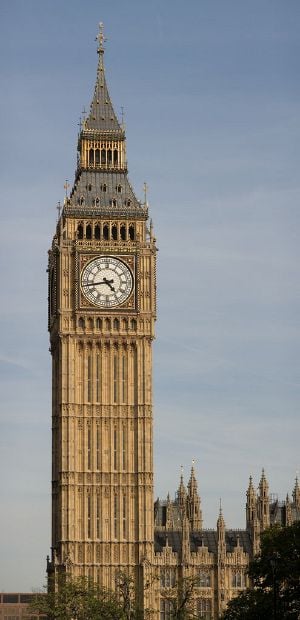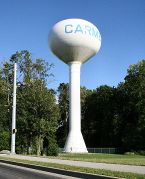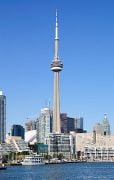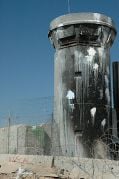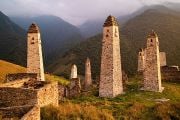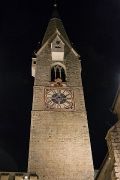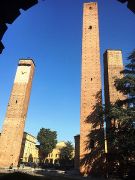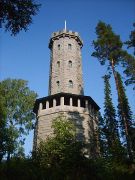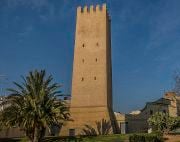Difference between revisions of "Tower" - New World Encyclopedia
| (44 intermediate revisions by the same user not shown) | |||
| Line 1: | Line 1: | ||
| + | {{Images OK}}{{Submitted}}{{Approved}}{{Copyedited}} | ||
| + | [[File:Tokyo Sky Tree 2012.JPG|thumb|300px|[[Tokyo Skytree]], the tallest tower in the world]] | ||
| + | A '''tower''' is a tall [[Nonbuilding structure|structure]], taller than it is wide, often by a significant factor. Towers are distinguished from [[guyed mast|masts]] by their lack of [[guy-wires]] and are therefore, along with tall buildings, self-supporting structures. A tower can stand alone or be connected to adjacent buildings, or it may be a feature on top of a larger structure or building. | ||
| − | [[ | + | Towers are specifically distinguished from [[building]]s in that they are built not to be habitable but to serve other functions using the [[height]] of the tower. For example, the height of a [[clock tower]] improves the visibility of the [[clock]], and the height of a tower in a fortified building such as a [[castle]] increases the visibility of the surroundings for defensive purposes. Towers may also be built for [[observation tower|observation]], leisure, or [[telecommunication]] purposes. |
| − | [[ | + | {{toc}} |
| − | + | Whatever its purpose, a tower is always a striking piece of [[architecture]] and [[engineering]], combining function with [[aesthetic]] appeal, an example of human [[creativity]] that attracts the attention of all who see it. | |
| − | [[ | + | ==Etymology== |
| + | [[Old English]] ''torr'' is from [[Latin]] ''turris'' ("a tower, citadel, high structure") via [[Old French]] ''tor'', which became Modern French ''tour''; Spanish and Italian ''torre''.<ref>[https://www.etymonline.com/word/tower tower] ''Etymology Online''. Retrieved April 28, 2024.</ref> | ||
| + | |||
| + | The Latin term together with [[Greek language|Greek]] ''τύρσις'' was loaned from a pre-Indo-European Mediterranean language, connected with the [[Illyrian language|Illyrian]] toponym Βου-δοργίς. With the [[Lydian language|Lydian]] toponyms Τύρρα, Τύρσα, it has been connected with the ethnonym [[Tyrrhenians|Τυρρήνιοι]] as well as with ''Tusci'' (from ''*Turs-ci''), the Greek and Latin names for the [[Etruscans]].<ref>Paul Kretschmer and Wilhelm Kroll, ''Glotta: Zeitschrift für Griechische und Lateinische Sprache'' (Göttingen: Vandenhoeck und Ruprecht, 1909-1934).</ref> | ||
| − | + | ==History== | |
| + | [[File:Mousa Broch 20080821 02.jpg|thumb|400px|Mousa Broch, [[Shetland]], [[Scotland]], constructed c. 300 B.C.E..]] | ||
| + | [[File:Leaning Tower of Pisa.jpg|thumb|300px|Leaning Tower of Pisa]] | ||
| + | Towers have been used by humankind since prehistoric times. The oldest known may be the circular stone tower in walls of [[Jericho]], dated to 8000 B.C.E.<ref> Kathleen M. Kenyon and T.A. Holland, ''Excavations at Jericho Volume Three: The Architecture and Stratigraphy of the Tell'' (Council for British Research in the Levant, 1981, ISBN 978-0950054230).</ref> Some of the earliest towers were [[ziggurat]]s, which existed in [[Sumerian architecture]] since the fourth millennium B.C.E. The most famous ziggurats include the Sumerian [[Ziggurat of Ur]], built in the third millennium B.C.E., and the [[Etemenanki]] dedicated to the Mesopotamian god [[Marduk]] in the ancient city of [[Babylon]]. | ||
| − | + | Some of the earliest surviving examples are the [[prehistoric]] [[broch]] structures in northern [[Scotland]], which are conical [[tower house]]s.<ref> Ian Armit, ''Towers in the North'' (The History Press, 2002, ISBN 978-0752419329).</ref> These brochs, and various examples from [[Phoenicia]]n and [[Ancient Rome|Roman]] cultures, emphasized the use of a tower in fortification and sentinel roles as well as for habitation. | |
| − | + | The Romans utilized octagonal towers as elements of [[Diocletian's Palace]] in [[Croatia]], which dates to approximately 300 C.E.<ref>[https://www.megalithic.co.uk/article.php?sid=17691 Diocletian's Palace] ''The Megalithic Portal''. Retrieved April 28, 2024.</ref> The [[Servian Walls]] constructed in the early fourth century B.C.E.. around the city of Rome, and the [[Aurelian Walls]] that replaced them in the third century C.E., featured square towers. The Chinese used towers as integrated elements of the [[Great Wall of China]] in 210 B.C.E.. during the [[Qin Dynasty]]. Towers were also an important element of [[medieval]] [[castle]]s. | |
| − | [[ | ||
| − | |||
| − | + | Other well known historical towers include the [[Leaning Tower of Pisa]] in [[Pisa, Italy]] built from 1173 until 1372, the [[Two Towers, Bologna|Two Towers]] in [[Bologna, Italy]] built from 1109 until 1119, and the [[Towers of Pavia]] (25 survive), built between eleventh and thirteenth century. The [[Himalayan Towers]] are stone towers located chiefly in [[Tibet]] built approximately fourteenth to fifteenth century. | |
| − | [[ | + | <ref>Dana Thomas, [https://web.archive.org/web/20040409183554/http://msnbc.msn.com/id/3474951/ "Towers to the Heavens"], ''Newsweek'' (November 15, 2003). Retrieved April 28, 2024.</ref> |
| − | |||
| − | + | Today, towers continue to be built, often to incredible heights, with their designers aiming to build the tallest structure in the world. Although not correctly defined as towers, many modern [[high-rise building]]s (in particular [[skyscraper]]s) have "tower" in their name or are colloquially called "towers." In the [[United States]], the original [[World Trade Center]] had the nickname the Twin Towers, a name shared with the [[Petronas Twin Towers]] in [[Kuala Lumpur]]. However, skyscrapers are more properly classified as [[building]]s, since their purpose is for habitation and/or offices. | |
| − | [[File: | + | [[File:Römerturm, Auf dem Gaulskopf.jpg|thumb|300px|[[Ancient Rome|Roman]] tower ([[Reconstruction (architecture)|reconstruction]]) at [[Upper Germanic-Rhaetian Limes|Limes]] – [[Taunus]] / Germany]] |
| − | |||
| − | |||
==Mechanics== | ==Mechanics== | ||
| + | [[File:Azadi tower 9.jpg|thumb|400px|[[Azadi Tower]] in [[Tehran]], [[Iran]]; an example of [[Iranian architecture]] of various periods]] | ||
| + | |||
| + | [[File:The Eiffel Tower, Paris, France.jpg|thumb|right|300px|[[Eiffel Tower]] in Paris]] | ||
Up to a certain height, a tower can be made with the supporting structure with parallel sides. However, above a certain height, the compressive load of the material is exceeded, and the tower will fail. This can be avoided if the tower's support structure tapers up the building. | Up to a certain height, a tower can be made with the supporting structure with parallel sides. However, above a certain height, the compressive load of the material is exceeded, and the tower will fail. This can be avoided if the tower's support structure tapers up the building. | ||
| − | A second limit is that of buckling—the structure requires sufficient stiffness to avoid breaking under the loads it faces, especially those due to | + | A second limit is that of buckling—the structure requires sufficient stiffness to avoid breaking under the loads it faces, especially those due to [[wind]]s. Many very tall towers have their support structures at the periphery of the building, which greatly increases the overall stiffness. |
| − | A third limit is dynamic | + | A third limit is dynamic: A tower is subject to varying winds, vortex shedding, [[earthquake|seismic disturbance]]s, and so forth. These are often dealt with through a combination of simple strength and stiffness, as well as in some cases [[tuned mass damper]]s to damp out movements.<ref>Tim Heffernan, [https://www.popularmechanics.com/technology/infrastructure/a14564/the-121-story-tower-that-never-sways/ The World's Second-Tallest Building Sways, But Here's Why You Can't Feel It] ''Popular Mechanics'' (March 18, 2015). Retrieved April 28, 2024.</ref> Varying or tapering the outer aspect of the tower with height avoids vibrations due to vortex shedding occurring along the entire building simultaneously. |
==Functions== | ==Functions== | ||
| − | + | Towers have been built since ancient, even prehistoric, times, often for defensive purposes. However, there are numerous other functions that these tall structure perform. | |
===Strategic advantages=== | ===Strategic advantages=== | ||
| − | The tower throughout history has provided its users with an advantage in surveying defensive positions and obtaining a better view of the surrounding areas, including battlefields. | + | The tower throughout history has provided its users with an advantage in surveying defensive positions and obtaining a better view of the surrounding areas, including battlefields. Observation towers that are used as guard posts or observation posts over an extended period to overlook an area are commonly called [[watchtower]]s. |
| + | |||
| + | Strategic towers could be constructed on [[defensive wall]]s, or rolled near a target, as a [[siege tower]]. Today, strategic-use towers are still used at [[prison]]s, military camps, and defensive perimeters. | ||
===Potential energy=== | ===Potential energy=== | ||
| − | By using gravity to move objects or substances downward, a tower can be used to store items or liquids | + | By using gravity to move objects or substances downward, a tower can be used to store items or liquids, such as in a [[storage silo]] or a [[water tower]], or aim an object into the earth such as a [[drilling tower]]. [[ski jumping|Ski-jump ramps]] use the same idea, and in the absence of a natural mountain slope or hill, can be human-made. |
===Communication enhancement=== | ===Communication enhancement=== | ||
| − | In history, simple towers like [[lighthouse]]s, [[bell tower]]s, [[clock tower]]s, [[Signal box|signal towers]] and [[minaret]]s were used to communicate information over greater distances. In more recent years, [[radio mast]]s and cell phone towers facilitate communication by expanding the range of the transmitter. The [[CN Tower]] in [[Toronto, Ontario]], Canada was built as a communications tower, with the capability to act as both a transmitter and repeater. | + | In history, simple towers like [[lighthouse]]s, [[bell tower]]s, [[clock tower]]s, [[Signal box|signal towers]], and [[minaret]]s were used to communicate information over greater distances. Tall lighthouses and signal towers were constructed to stand like sentinels, guarding and warning those approaching of possible dangers.<ref>R.G. Grant, ''Lighthouse: An Illuminating History of the World's Coastal Sentinels'' (Black Dog & Leventhal, 2018, ISBN 978-0316414470).</ref> |
| + | |||
| + | In more recent years, [[radio mast]]s and cell phone towers facilitate communication by expanding the range of the transmitter. The [[CN Tower]] in [[Toronto, Ontario]], Canada was built as a communications tower, with the capability to act as both a transmitter and repeater. | ||
| + | |||
| + | ===Religious purpose=== | ||
| + | [[File:00 3920 St.-Michaelis-Kirche (Hamburg).jpg|thumb|300px|Evangelische Hauptkirche St. Michaelis in Hamburg, Germany]] | ||
| + | Religious buildings often include towers, since they were the most impressive and permanent buildings in any community. The towers were often used to call people to worship. For example, a muezzin would recite the [[Islam]]ic call to prayer (adhan), traditionally from a [[minaret]], a tower typically built into or adjacent to the [[mosque]]. [[Christian]] [[church]]es and [[cathedral]]s have often included a bell tower, containing the church bells that would be rung to announce the time for worship. Since medieval times, the church was often build with a steeple, which is a tower topped by a spire, which incorporates other components including the belfry which houses the church bells, as well as a clock. Many of these are recognized as significant architectural, artistic, and engineering achievements.<ref> Julian Flannery, ''Fifty English Steeples: The Finest Medieval Parish Church Towers and Spires in England'' (Thames & Hudson, 2016, ISBN 978-0500343142).</ref> | ||
| + | [[Image:Clock Tower - Palace of Westminster, London - September 2006.jpg|right|thumb|300px|The Elizabeth Tower, that houses [[Big Ben]], of the Palace of Westminster, [[London]]]] | ||
| + | In Asian countries [[pagoda]]s, tiered towers with multiple eaves, are built with a religious function, most often [[Buddhist]], but sometimes [[Taoist]]. They are often located in or near a Buddhist monastery, and were originally built to house Buddhist relics. | ||
===Transportation support=== | ===Transportation support=== | ||
| − | Towers can also be used to support | + | Towers can also be used to support [[bridge]]s, and can reach heights that rival some of the tallest buildings above-water. Their use is most prevalent in [[suspension bridge]]s and [[cable-stayed bridge]]s. The use of the [[pylon]], a simple tower structure, has also helped to build [[railroad]] bridges, mass-transit systems, and [[harbor]]s. |
[[Control tower]]s are used to give visibility to help direct aviation traffic. | [[Control tower]]s are used to give visibility to help direct aviation traffic. | ||
| − | ===Other=== | + | ===Other uses=== |
* To access tall or high objects: [[launch tower]], [[service tower]], [[service structure]], [[scaffolding|scaffold]], [[tower crane]] | * To access tall or high objects: [[launch tower]], [[service tower]], [[service structure]], [[scaffolding|scaffold]], [[tower crane]] | ||
* To access atmospheric conditions aloft: [[wind turbine]], meteorological [[measurement tower]], [[tower telescope]], [[solar thermal energy|solar power]] station | * To access atmospheric conditions aloft: [[wind turbine]], meteorological [[measurement tower]], [[tower telescope]], [[solar thermal energy|solar power]] station | ||
| Line 64: | Line 81: | ||
* For recreation: [[rock climbing|rock climbing tower]] | * For recreation: [[rock climbing|rock climbing tower]] | ||
* As a symbol: [[Tower of Babel]], [[The Tower (Tarot card)]], [[steeple|church tower]] | * As a symbol: [[Tower of Babel]], [[The Tower (Tarot card)]], [[steeple|church tower]] | ||
| − | |||
| − | |||
==Gallery== | ==Gallery== | ||
| Line 71: | Line 86: | ||
|File:Galata Tower January 2015.JPG|The [[Galata Tower]], also called ''Christea Turris'' (the Tower of Christ in Latin), was built in 1348 C.E. by the [[Republic of Genoa|Genoese]] colony in [[Constantinople]]. | |File:Galata Tower January 2015.JPG|The [[Galata Tower]], also called ''Christea Turris'' (the Tower of Christ in Latin), was built in 1348 C.E. by the [[Republic of Genoa|Genoese]] colony in [[Constantinople]]. | ||
|File:Carmel-indiana-water-tower.jpg|Typical modern water tower in [[Carmel, Indiana]], United States | |File:Carmel-indiana-water-tower.jpg|Typical modern water tower in [[Carmel, Indiana]], United States | ||
| − | |File: | + | |File:Toronto - ON - Toronto Harbourfront7.jpg|The CN Tower and the [[Toronto]] Harbour, Canada |
|File:Israeli West Bank barrier watchtower.jpg|Watchtower in the [[Israeli West Bank barrier]] | |File:Israeli West Bank barrier watchtower.jpg|Watchtower in the [[Israeli West Bank barrier]] | ||
| − | |||
|File:Caucasus, Ingushetia, Ингушские боевые и смотровые башни, горы Кавказа.jpg|Medieval military towers from [[Ingushetia]], [[Caucasus Mountains]] | |File:Caucasus, Ingushetia, Ингушские боевые и смотровые башни, горы Кавказа.jpg|Medieval military towers from [[Ingushetia]], [[Caucasus Mountains]] | ||
|File:Lifeguard tower, Asprovalta.jpg|[[Lifeguard|Lifeguard tower]], [[Asprovalta]] (Greece) | |File:Lifeguard tower, Asprovalta.jpg|[[Lifeguard|Lifeguard tower]], [[Asprovalta]] (Greece) | ||
| Line 81: | Line 95: | ||
|File:Hameenlinna Aulanko Nature Reserve tower.jpg|The Aulanko Tower at the [[Aulanko Nature Reserve]] in [[Hämeenlinna]], Finland | |File:Hameenlinna Aulanko Nature Reserve tower.jpg|The Aulanko Tower at the [[Aulanko Nature Reserve]] in [[Hämeenlinna]], Finland | ||
|File:Torre Racef (Almussafes).jpg|Rassef Islamic tower, [[Almussafes]] | |File:Torre Racef (Almussafes).jpg|Rassef Islamic tower, [[Almussafes]] | ||
| + | |File:Space Needle 2011-07-04.jpg|Space Needle, [[Seattle]] | ||
||title=}} | ||title=}} | ||
| − | |||
| − | |||
| − | |||
| − | |||
| − | |||
| − | |||
| − | |||
| − | |||
| − | |||
| − | |||
| − | |||
| − | |||
| − | |||
| − | |||
| − | |||
| − | |||
| − | |||
| − | |||
| − | |||
| − | |||
| − | |||
| − | |||
| − | |||
| − | |||
| − | |||
| − | |||
| − | |||
==Notes== | ==Notes== | ||
<references/> | <references/> | ||
| − | |||
==References== | ==References== | ||
| − | * | + | * Armit, Ian. ''Towers in the North''. The History Press, 2002. ISBN 978-0752419329 |
| + | * Flannery, Julian. ''Fifty English Steeples: The Finest Medieval Parish Church Towers and Spires in England''. Thames & Hudson, 2016. ISBN 978-0500343142 | ||
| + | * Grant, R.G. ''Lighthouse: An Illuminating History of the World's Coastal Sentinels''. Black Dog & Leventhal, 2018. ISBN 978-0316414470 | ||
| + | * Kenyon, Kathleen M., and T.A. Holland. ''Excavations at Jericho Volume Three: The Architecture and Stratigraphy of the Tell''. Council for British Research in the Levant, 1981. ISBN 978-0950054230 | ||
| + | * Kretschmer, Paul, and Wilhelm Kroll. ''Glotta: Zeitschrift für Griechische und Lateinische Sprache''. Göttingen: Vandenhoeck und Ruprecht, 1909-1934. | ||
==External links== | ==External links== | ||
| + | All links retrieved April 27, 2024. | ||
| + | * [https://www.verdin.com/towers/ Bell & Clock Towers] ''Verdin'' | ||
| + | * [https://www.pocketbuildings.com/blog/clock-towers-architecture 11 Famous Clock Towers] ''Pocket Buildings'' | ||
| + | * [https://www.bibleplaces.com/watchtowers/ Watchtowers] ''Bible Places'' | ||
| + | * [https://www.thetouriosity.com/post/13-historical-towers-of-the-world 13 Historical Towers of the World] ''Touriosity'' | ||
| + | * [https://www.archdaily.com/981200/a-view-from-the-top-the-history-of-observation-towers A View From the Top: The History of Observation Towers] ''Arch Daily'' | ||
| + | * [https://www.historicenvironment.scot/visit-a-place/places/mousa-broch/ Mousa Broch] ''Historic Environment Scotland'' | ||
[[Category:Physical sciences]] | [[Category:Physical sciences]] | ||
[[Category:Architecture]] | [[Category:Architecture]] | ||
{{Credits|Tower|1210959080}} | {{Credits|Tower|1210959080}} | ||
Latest revision as of 16:19, 29 April 2024
A tower is a tall structure, taller than it is wide, often by a significant factor. Towers are distinguished from masts by their lack of guy-wires and are therefore, along with tall buildings, self-supporting structures. A tower can stand alone or be connected to adjacent buildings, or it may be a feature on top of a larger structure or building.
Towers are specifically distinguished from buildings in that they are built not to be habitable but to serve other functions using the height of the tower. For example, the height of a clock tower improves the visibility of the clock, and the height of a tower in a fortified building such as a castle increases the visibility of the surroundings for defensive purposes. Towers may also be built for observation, leisure, or telecommunication purposes.
Whatever its purpose, a tower is always a striking piece of architecture and engineering, combining function with aesthetic appeal, an example of human creativity that attracts the attention of all who see it.
Etymology
Old English torr is from Latin turris ("a tower, citadel, high structure") via Old French tor, which became Modern French tour; Spanish and Italian torre.[1]
The Latin term together with Greek τύρσις was loaned from a pre-Indo-European Mediterranean language, connected with the Illyrian toponym Βου-δοργίς. With the Lydian toponyms Τύρρα, Τύρσα, it has been connected with the ethnonym Τυρρήνιοι as well as with Tusci (from *Turs-ci), the Greek and Latin names for the Etruscans.[2]
History
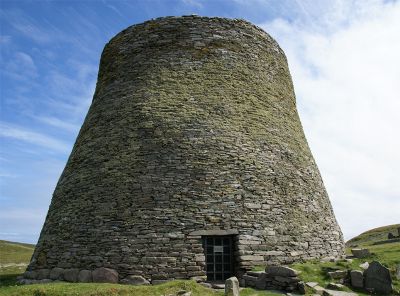
Towers have been used by humankind since prehistoric times. The oldest known may be the circular stone tower in walls of Jericho, dated to 8000 B.C.E.[3] Some of the earliest towers were ziggurats, which existed in Sumerian architecture since the fourth millennium B.C.E. The most famous ziggurats include the Sumerian Ziggurat of Ur, built in the third millennium B.C.E., and the Etemenanki dedicated to the Mesopotamian god Marduk in the ancient city of Babylon.
Some of the earliest surviving examples are the prehistoric broch structures in northern Scotland, which are conical tower houses.[4] These brochs, and various examples from Phoenician and Roman cultures, emphasized the use of a tower in fortification and sentinel roles as well as for habitation.
The Romans utilized octagonal towers as elements of Diocletian's Palace in Croatia, which dates to approximately 300 C.E.[5] The Servian Walls constructed in the early fourth century B.C.E. around the city of Rome, and the Aurelian Walls that replaced them in the third century C.E., featured square towers. The Chinese used towers as integrated elements of the Great Wall of China in 210 B.C.E. during the Qin Dynasty. Towers were also an important element of medieval castles.
Other well known historical towers include the Leaning Tower of Pisa in Pisa, Italy built from 1173 until 1372, the Two Towers in Bologna, Italy built from 1109 until 1119, and the Towers of Pavia (25 survive), built between eleventh and thirteenth century. The Himalayan Towers are stone towers located chiefly in Tibet built approximately fourteenth to fifteenth century. [6]
Today, towers continue to be built, often to incredible heights, with their designers aiming to build the tallest structure in the world. Although not correctly defined as towers, many modern high-rise buildings (in particular skyscrapers) have "tower" in their name or are colloquially called "towers." In the United States, the original World Trade Center had the nickname the Twin Towers, a name shared with the Petronas Twin Towers in Kuala Lumpur. However, skyscrapers are more properly classified as buildings, since their purpose is for habitation and/or offices.
Mechanics

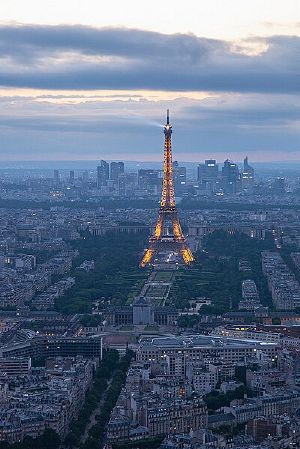
Up to a certain height, a tower can be made with the supporting structure with parallel sides. However, above a certain height, the compressive load of the material is exceeded, and the tower will fail. This can be avoided if the tower's support structure tapers up the building.
A second limit is that of buckling—the structure requires sufficient stiffness to avoid breaking under the loads it faces, especially those due to winds. Many very tall towers have their support structures at the periphery of the building, which greatly increases the overall stiffness.
A third limit is dynamic: A tower is subject to varying winds, vortex shedding, seismic disturbances, and so forth. These are often dealt with through a combination of simple strength and stiffness, as well as in some cases tuned mass dampers to damp out movements.[7] Varying or tapering the outer aspect of the tower with height avoids vibrations due to vortex shedding occurring along the entire building simultaneously.
Functions
Towers have been built since ancient, even prehistoric, times, often for defensive purposes. However, there are numerous other functions that these tall structure perform.
Strategic advantages
The tower throughout history has provided its users with an advantage in surveying defensive positions and obtaining a better view of the surrounding areas, including battlefields. Observation towers that are used as guard posts or observation posts over an extended period to overlook an area are commonly called watchtowers.
Strategic towers could be constructed on defensive walls, or rolled near a target, as a siege tower. Today, strategic-use towers are still used at prisons, military camps, and defensive perimeters.
Potential energy
By using gravity to move objects or substances downward, a tower can be used to store items or liquids, such as in a storage silo or a water tower, or aim an object into the earth such as a drilling tower. Ski-jump ramps use the same idea, and in the absence of a natural mountain slope or hill, can be human-made.
Communication enhancement
In history, simple towers like lighthouses, bell towers, clock towers, signal towers, and minarets were used to communicate information over greater distances. Tall lighthouses and signal towers were constructed to stand like sentinels, guarding and warning those approaching of possible dangers.[8]
In more recent years, radio masts and cell phone towers facilitate communication by expanding the range of the transmitter. The CN Tower in Toronto, Ontario, Canada was built as a communications tower, with the capability to act as both a transmitter and repeater.
Religious purpose
Religious buildings often include towers, since they were the most impressive and permanent buildings in any community. The towers were often used to call people to worship. For example, a muezzin would recite the Islamic call to prayer (adhan), traditionally from a minaret, a tower typically built into or adjacent to the mosque. Christian churches and cathedrals have often included a bell tower, containing the church bells that would be rung to announce the time for worship. Since medieval times, the church was often build with a steeple, which is a tower topped by a spire, which incorporates other components including the belfry which houses the church bells, as well as a clock. Many of these are recognized as significant architectural, artistic, and engineering achievements.[9]
In Asian countries pagodas, tiered towers with multiple eaves, are built with a religious function, most often Buddhist, but sometimes Taoist. They are often located in or near a Buddhist monastery, and were originally built to house Buddhist relics.
Transportation support
Towers can also be used to support bridges, and can reach heights that rival some of the tallest buildings above-water. Their use is most prevalent in suspension bridges and cable-stayed bridges. The use of the pylon, a simple tower structure, has also helped to build railroad bridges, mass-transit systems, and harbors.
Control towers are used to give visibility to help direct aviation traffic.
Other uses
- To access tall or high objects: launch tower, service tower, service structure, scaffold, tower crane
- To access atmospheric conditions aloft: wind turbine, meteorological measurement tower, tower telescope, solar power station
- To lift high tension cables for electrical power distribution transmission tower
- To take advantage of the temperature gradient inherent in a height differential: cooling tower
- To expel and disperse potentially harmful gases and particulates into the atmosphere: chimney
- To protect from exposure: BREN Tower, lightning rod tower
- For industrial production: shot tower
- For surveying: Survey tower
- To drop objects: Drop tube (drop tower), bomb tower, diving platform
- To test height-intensive applications: elevator test tower
- To improve structural integrity: thyristor tower
- To mimic towers or provide height for training purposes: fire tower, parachute tower
- As art: Shukhov Tower
- For recreation: rock climbing tower
- As a symbol: Tower of Babel, The Tower (Tarot card), church tower
Gallery
|
Notes
- ↑ tower Etymology Online. Retrieved April 28, 2024.
- ↑ Paul Kretschmer and Wilhelm Kroll, Glotta: Zeitschrift für Griechische und Lateinische Sprache (Göttingen: Vandenhoeck und Ruprecht, 1909-1934).
- ↑ Kathleen M. Kenyon and T.A. Holland, Excavations at Jericho Volume Three: The Architecture and Stratigraphy of the Tell (Council for British Research in the Levant, 1981, ISBN 978-0950054230).
- ↑ Ian Armit, Towers in the North (The History Press, 2002, ISBN 978-0752419329).
- ↑ Diocletian's Palace The Megalithic Portal. Retrieved April 28, 2024.
- ↑ Dana Thomas, "Towers to the Heavens", Newsweek (November 15, 2003). Retrieved April 28, 2024.
- ↑ Tim Heffernan, The World's Second-Tallest Building Sways, But Here's Why You Can't Feel It Popular Mechanics (March 18, 2015). Retrieved April 28, 2024.
- ↑ R.G. Grant, Lighthouse: An Illuminating History of the World's Coastal Sentinels (Black Dog & Leventhal, 2018, ISBN 978-0316414470).
- ↑ Julian Flannery, Fifty English Steeples: The Finest Medieval Parish Church Towers and Spires in England (Thames & Hudson, 2016, ISBN 978-0500343142).
ReferencesISBN links support NWE through referral fees
- Armit, Ian. Towers in the North. The History Press, 2002. ISBN 978-0752419329
- Flannery, Julian. Fifty English Steeples: The Finest Medieval Parish Church Towers and Spires in England. Thames & Hudson, 2016. ISBN 978-0500343142
- Grant, R.G. Lighthouse: An Illuminating History of the World's Coastal Sentinels. Black Dog & Leventhal, 2018. ISBN 978-0316414470
- Kenyon, Kathleen M., and T.A. Holland. Excavations at Jericho Volume Three: The Architecture and Stratigraphy of the Tell. Council for British Research in the Levant, 1981. ISBN 978-0950054230
- Kretschmer, Paul, and Wilhelm Kroll. Glotta: Zeitschrift für Griechische und Lateinische Sprache. Göttingen: Vandenhoeck und Ruprecht, 1909-1934.
External links
All links retrieved April 27, 2024.
- Bell & Clock Towers Verdin
- 11 Famous Clock Towers Pocket Buildings
- Watchtowers Bible Places
- 13 Historical Towers of the World Touriosity
- A View From the Top: The History of Observation Towers Arch Daily
- Mousa Broch Historic Environment Scotland
Credits
New World Encyclopedia writers and editors rewrote and completed the Wikipedia article in accordance with New World Encyclopedia standards. This article abides by terms of the Creative Commons CC-by-sa 3.0 License (CC-by-sa), which may be used and disseminated with proper attribution. Credit is due under the terms of this license that can reference both the New World Encyclopedia contributors and the selfless volunteer contributors of the Wikimedia Foundation. To cite this article click here for a list of acceptable citing formats.The history of earlier contributions by wikipedians is accessible to researchers here:
The history of this article since it was imported to New World Encyclopedia:
Note: Some restrictions may apply to use of individual images which are separately licensed.
